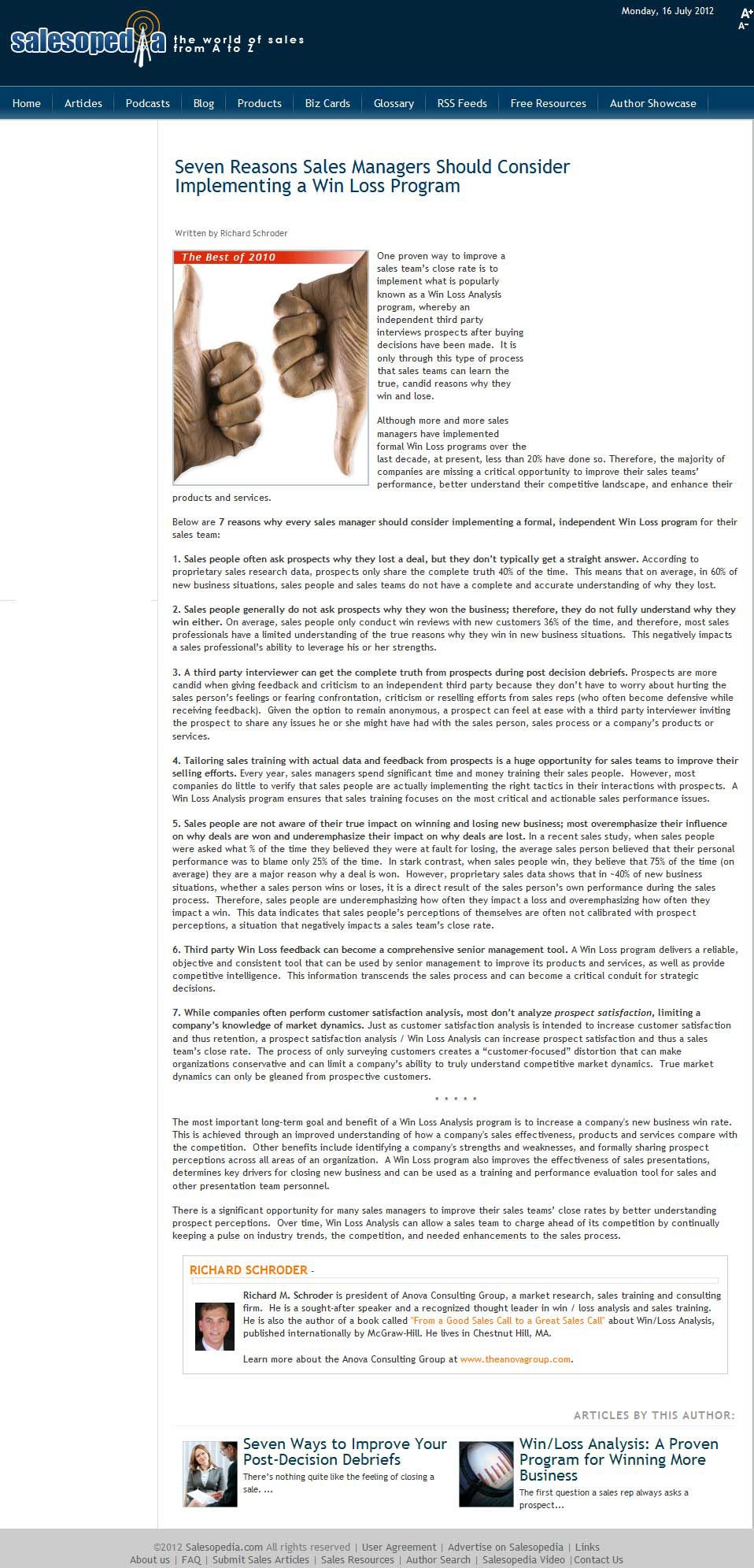


One proven way to improve a sales team’s close rate is to implement what is popularly known as a Win Loss Analysis program, whereby an independent third party interviews prospects after buying decisions have been made. It is only through this type of process that sales teams can learn the true, candid reasons why they win and lose.
Although more and more sales managers have implemented formal programs over the last decade, at present, less than 20% have done so. Therefore, the majority of companies are missing a critical opportunity to improve their sales teams’ performance, better understand their competitive landscape, and enhance their products and services.
1. Sales people often ask prospects why they lost a deal, but they don’t typically get a straight answer. According to proprietary sales research data, prospects only share the complete truth 40% of the time. This means that on average, in 60% of new business situations, sales people and sales teams do not have a complete and accurate understanding of why they lost.
2. Sales people generally do not ask prospects why they won the business; therefore, they do not fully understand why they win either. On average, sales people only conduct win reviews with new customers 36% of the time, and therefore, most sales professionals have a limited understanding of the true reasons why they win in new business situations. This negatively impacts a sales professional’s ability to leverage his or her strengths.
3. A third party interviewer can get the complete truth from prospects during post decision debriefs. Prospects are more candid when giving feedback and criticism to an independent third party because they don’t have to worry about hurting the sales person’s feelings or fearing confrontation, criticism or reselling efforts from sales reps (who often become defensive while receiving feedback). Given the option to remain anonymous, a prospect can feel at ease with a third party interviewer inviting the prospect to share any issues he or she might have had with the sales person, sales process or a company’s products or services.
4. Tailoring sales training with actual Win / Loss analysis data and feedback from prospects is a huge opportunity for sales teams to improve their selling efforts. Every year, sales managers spend significant time and money training their sales people. However, most companies do little to verify that sales people are actually implementing the right tactics in their interactions with prospects. A Win Loss Analysis program ensures that sales training focuses on the most critical and actionable sales performance issues.
5. Sales people are not aware of their true impact on winning and losing new business; most overemphasize their influence on why deals are won and underemphasize their impact on why deals are lost. In a recent sales study, when sales people were asked what % of the time they believed they were at fault for losing, the average sales person believed that their personal performance was to blame only 25% of the time. In stark contrast, when sales people win, they believe that 75% of the time (on average) they are a major reason why a deal is won. However, proprietary analysis sales data shows that in ~40% of new business situations, whether a sales person wins or loses, it is a direct result of the sales person’s own performance during the sales process. Therefore, sales people are underemphasizing how often they impact a loss and overemphasizing how often they impact a win. This data indicates that sales people’s perceptions of themselves are often not calibrated with prospect perceptions, a situation that negatively impacts a sales team’s close rate.
6. Third party feedback can become a comprehensive senior management tool. A Win Loss Analysis program delivers a reliable, objective and consistent tool that can be used by senior management to improve its products and services, as well as provide competitive intelligence. This information transcends the sales process and can become a critical conduit for strategic decisions.
7. While companies often perform customer satisfaction analysis, most don’t analyze prospect satisfaction, limiting a company’s knowledge of market dynamics. Just as customer satisfaction analysis is intended to increase customer satisfaction and thus retention, a prospect satisfaction analysis can increase prospect satisfaction and thus a sales team’s close rate. The process of only surveying customers creates a “customer-focused” distortion that can make organizations conservative and can limit a company’s ability to truly understand competitive market dynamics. True market dynamics can only be gleaned from prospective customers.
The most important long-term goal and benefit of a Win Loss Analysis program is to increase a company’s new business win rate. This is achieved through an improved understanding of how a company’s sales effectiveness, products and services compare with the competition. Other benefits include identifying a company’s strengths and weaknesses, and formally sharing prospect perceptions across all areas of an organization. Such a program also improves the effectiveness of sales presentations, determines key drivers for closing new business and can be used as a training and performance evaluation tool for sales and other presentation team personnel.
There is a significant opportunity for many sales managers to improve their sales teams’ close rates by better understanding prospect perceptions. Over time, Win Loss Analysis can allow a sales team to charge ahead of its competition by continually keeping a pulse on industry trends, the competition, and needed enhancements to the sales process.